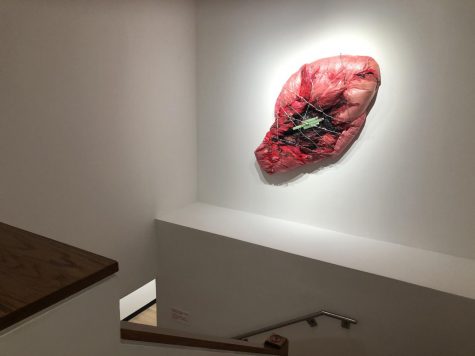Health, Fertility, Agency: The MoCP’s latest exhibit explores reproductive justice
February 22, 2021

A photo of a uterus, post-hysterectomy, hangs along a white wall. Next to it are tools used for an abortion and a womb, superimposed on fruit.
The art pieces can be found in the Museum of Contemporary Photography’s latest exhibit, “Reproductive: Health, Fertility, Agency.” The exhibit focuses on artwork related to reproductive justice and women’s rights, according to Kristin Taylor, curator of Academic Programs and Collections at the MoCP and co-curator of the exhibit.
“It started out as discussions about how little you see these topics addressed in art, but also in culture at large,” Taylor said. “Women are expected to go through a lot of these experiences alone.”
The exhibit, curated by Taylor and Karen Irvine, deputy director and chief curator of the MoCP, explores the “psychological, physical and emotional realities people encounter in the years leading up to, during and after fertility,” according to its website.
Krista Franklin, a 2013 Columbia alum, has artwork featured in the exhibit. Her work comes from her published book “Under The Knife,” which addresses her personal struggle with uterine fibroids, a type of growth that causes pain and complications related to menstruation.
“I think the curators of this particular exhibition are incredibly courageous,” Franklin said. “I feel very lucky to have my work included in this exhibit.”
The exhibit addresses a variety of reproductive topics through art, including abortion, infertility, birth and miscarriage.

In conjunction with the space, the museum is also hosting several virtual events aimed at raising awareness of reproductive bodily issues, platforming human rights activists and discussing art related to these topics.
On Feb. 10, the museum hosted a talk with feminist activist Loretta J. Ross, who gave a brief overview of her involvement with the Reproductive Justice Movement. The event, which was open to the public through Zoom, included a section where audience members could ask Ross questions related to her work.
Ross, a professor of women and gender studies at Smith College, and 11 other women began using the term reproductive justice to describe the movement in 1994 at an Illinois Pro-Choice Alliance conference, she said at the event.
“We consider controlling our fertility as an essential act of self determination while we are fighting against these stereotypes of Black women as unnatural women or bad mothers,” Ross said.
On Thursday, Feb. 18, the museum hosted a teen education workshop, where participants of all ages were involved with “getting people to understand anatomy better, and getting to understand the needs of [their] bodies,” Taylor said.
The museum is also hosting several lectures with the artists of the exhibit, including Carmen Winant and Candice Breitz, and a panel discussion March 10 called “Destigmatizing Reproductive Health,” where panelists, including OB-GYN Wendy C. Goodall McDonald, will discuss “historical and contemporary misconceptions of the female body,” according to the museum’s website.
The exhibit, which was originally scheduled for last fall, will be up for the duration of Black History Month and Women’s History Month and will remain open until May 23.
“I hope that the human rights issues that are being highlighted through this exhibition are recognized and that systemic, legislative and medical change begins to happen in this country,” Franklin said. “That’s what this entire exhibition is about.”







